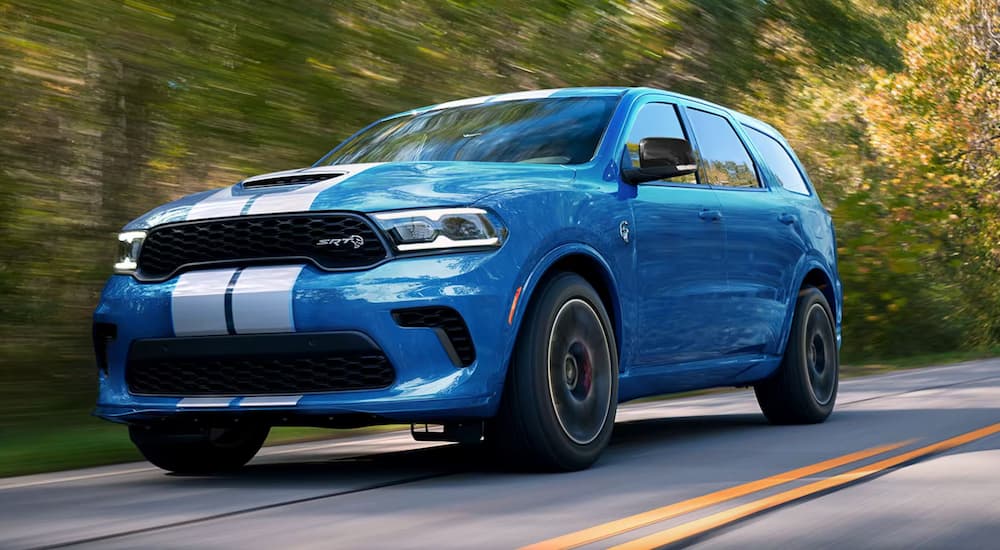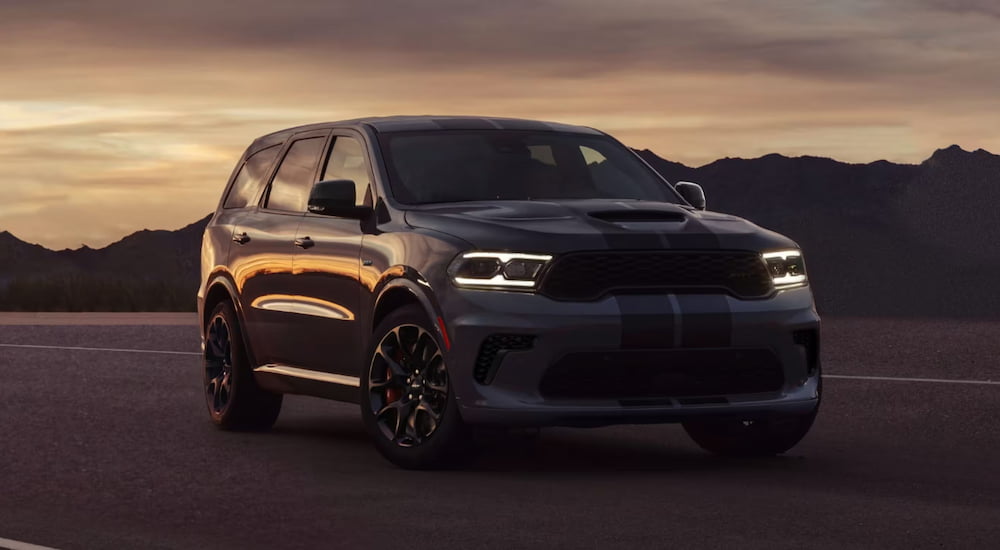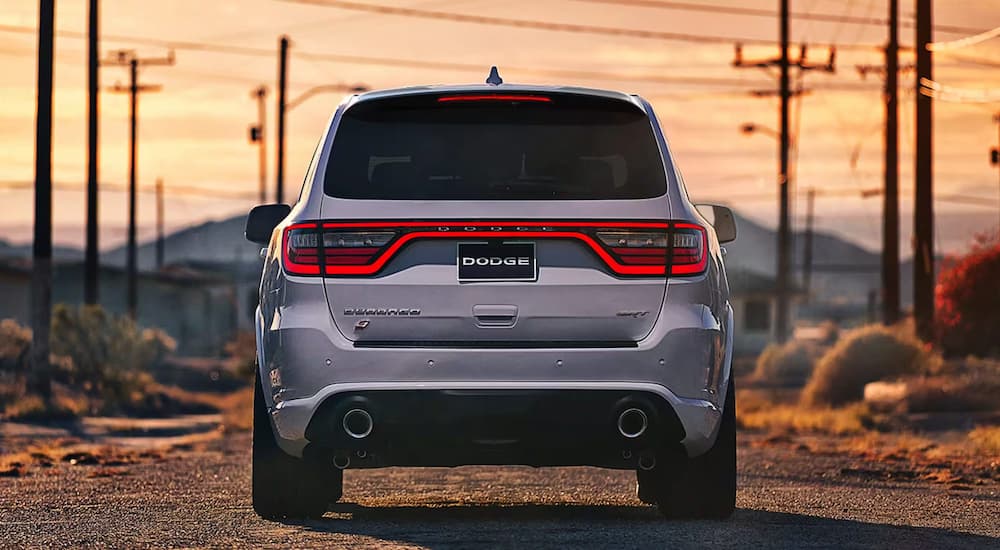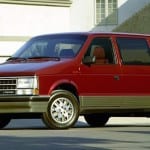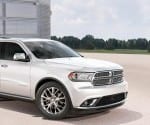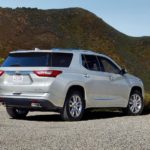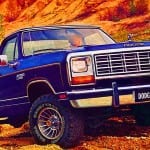If you love a big vehicle with big attitude, you’ve probably seen the latest Dodge Durango for sale, and maybe you even own one. This muscular three-row SUV has been around for many years, and while most SUVs focus on interior space and perhaps even towing capacity, the Durango has always stood out for its road performance. Today, several high-powered variants can zoom from zero to sixty in under four seconds, and even the base models offer a mix of power and athleticism that’s hard to come by in the three-row midsize SUV segment.
But while the Durango is unique and has plenty of fans, it has been losing steam with the general public in recent years. It failed to crack the list of Top 25 Best-Selling SUVs in the country in 2023, as drivers gravitated toward more fuel-efficient models that don’t have thirsty V8 engines under the hood. While the HEMI V8 is powerful, it is behind on the times when it comes to fuel economy, hence why Dodge’s parent company, Stellantis, has been removing the HEMI from multiple models over the last few years, including the Dodge Charger and Jeep Wagoneer—and it seems like the time has come for the Durango to meet the same fate.
So it’s the last call for a Durango with a HEMI V8; if you want one, now is the time to strike. But what about the Durango itself? Will it be returning for 2025? Rumor has it that it might not be. While some have predicted that the Durango will likely continue into 2025 (and merely switch to a Hurricane I-6 engine), others have reported that it will be replaced by an all-new three-row SUV called the Stealth (a moniker that holds a place in Dodge’s history—but that’s a story for another day). Whether it’s here to stay or shall soon say goodbye, the Durango is an iconic nameplate worth taking a look at; so, let’s review the current Durango, dive into its past, and discuss what might be coming for its future.
The 2024 Dodge Durango
The 2024 Durango stands out from a crowded field of SUVs mainly by delivering top-notch performance. Many mainstream SUVs are powered by engines that reviewers call “anemic” since they lack energy—especially in situations where quick acceleration is vital, like passing on the highway—but you’d be hard-pressed to find someone levying that complaint against the Durango. Even its base engine, a 3.6L Pentastar V6, offers impressive stats: 295 hp, 260 lb-ft of torque, and a towing capacity of 6,200 lbs. An available 5.7L HEMI V8 brings those numbers up to 360 hp, 390 lb-ft of torque, and 8,700 lbs of towing. At this point, Dodge starts to introduce another stat—one you won’t usually find associated with three-row SUVs: a noteworthy acceleration time.
The lowest-powered HEMI in the lineup—the 5.7L V8—gets from zero to sixty in 6.2 seconds, but the most noteworthy Durangos are the trims that use the two most powerful V8s available. The Durango SRT features a 6.4L HEMI V8 that produces 475 hp and 470 lb-ft of torque, letting it tow 8,700 lbs and go from zero to sixty in 4.4 seconds. Performance is such a focus for this trim that you can get it with summer tires, which is a rare outfit for a three-row SUV! Even those who know next to nothing about the automotive world will be able to tell that this vehicle is particularly fast, thanks to an eye-catching double racing stripe.
At the very top of the pack is the Durango SRT Hellcat. Its supercharged 6.2L HEMI V8 puts the preceding engines to shame with its 710 hp and 645 lb-ft of torque. It has a 3.5-second zero-to-sixty time but still manages to sneak in some practicality by maintaining the 8,700 lb towing capacity. With those numbers, it’s easy to forget that we’re talking about a midsize SUV and not a sleek sportscar. That’s all certainly impressive, no doubt, but it’s worth noting that many reviewers have asked a variation of the same question: “Who is this for?” That probably goes a long way toward explaining the Dodge Durango SRT’s “Last Call” edition, which is allowing the HEMI-powered Durango to go out with a bang, with exclusive styling touches that are as bold as the existence of such a sporty SUV.
The Original Durango (1998-2003)
While the 1998 Dodge Durango has a lot in common (on paper) with the 2024 model—in that they both have three rows, are powered by V8s, and boast high towing limits—you’d be forgiven for not seeing the connection when looking at the two side-by-side. The original Durango was built to compete with the likes of the Ford Explorer and Toyota 4Runner, and it’s more visually reminiscent of those models than of a muscle car. It shared a platform with the Dodge Dakota, back when pickup trucks were still made under the Dodge brand and handled like you would expect a truck from 1998 to. While many would call it strong and capable, the word “performance” was certainly not in the mix.
Bigger & Better (2004-2009)
A redesigned Durango gained more interior space and delivered better ride quality than first-generation models. Notably, this era introduced the legendary HEMI V8, with a 5.7L version providing 340 hp. The exterior styling was less truck-like, and it almost leaned more toward a minivan with its rounded front face features. Overall, it wasn’t the best generation, which might explain why there was a gap between this one and the next.
Back With a Vengeance (2011-2013)
Skipping over the 2010 model year, the Durango returned in 2011 and finally started to look something like the Durango of today. Riding on the same chassis as the Jeep Grand Cherokee, this generation had a square face and bold stance that gave it a much more pronounced “cool” factor than anything that had come before. Powered by either a 290-hp Pentastar V6 or a 360-hp HEMI V8, this Durango also offered better performance than its predecessors.
Upping the Performance (2014-2024)
In the latest generation, the Durango has been incrementally moving closer and closer to the muscular SUV it is today. A 2014 redesign kept the same engine lineup but switched to a new eight-speed transmission and added “racetrack” inspired tail lights in the back. The SRT variant would be added to the lineup for the 2018 model year, with the SRT Hellcat following close behind for 2021.
What Comes Next for 2025?
With official “Last Call” editions already rolling out, it’s clear that a considerable evolution is coming for the Durango. There’s a general agreement that there won’t be a 2025 Durango with a HEMI V8 under the hood, but will the Durango roll into the 2025 model year with a more efficient Hurricane I-6 instead, or will it be replaced altogether by a new nameplate? With rumors flying and little confirmed news to go off of at the time of this writing, it’s hard to say for certain.
Dodge has been making some significant changes lately, putting the Challenger nameplate on an indefinite hiatus while announcing that future versions of the Charger will be available with either twin-turbo inline-sixes or electric motors, not HEMI V8s. Whichever way the Durango goes, it’s already made an enormous mark on automotive history, boldly going where other SUVs of its size dared not go. If this is the end of the line, at least we can say that it’s been a good ride.
